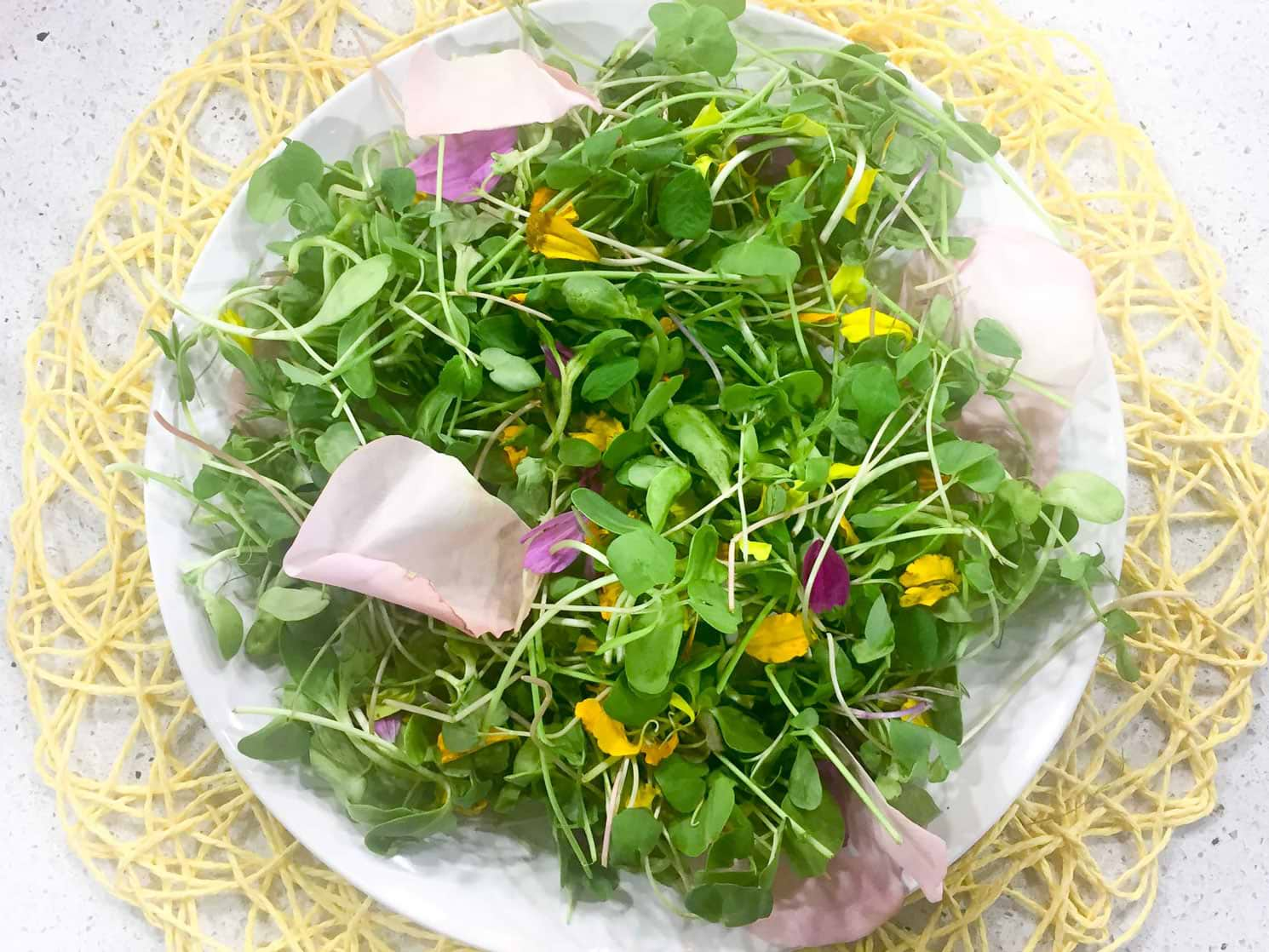Welcome to thoughtful, organic beauty
Hello Joyous is an organic, plant-based, sustainable beauty brand here to bring more joy to your day.
I had a super joyous morning today because I got to help the hosts of Your Morning christen their new show's new kitchen!
Since it's basically the television equivalent of a housewarming, I brought the traditional housewarming gifts of flowers, these flowers had a joyous twist: they were all edible!

Edible flowers are a great way to turn a ho-hum salad into something really special. Even if they don't end up on your plate, plants have a lot of other benefits too. Check out my video on the benefits of indoor plants for more reasons to bring plants into your home. Just remember to triple-check before deciding whether a plant is safe to eat!
I've highlighted some of my favourite edible flowers below including some joyous ways to incorporate them into recipes!
Anise Hyssop
These lavender-like flowers smell and taste of anise which you are probably used to smelling around Christmas time, due to their warming aroma of cloves and cinnamon. Both the flowers and leaves are edible and taste a bit like licorice. It's said to be great as a tea (the leaves especially are great for a cough and cold). It's also commonly dried and burned as inscents as it's really good at retaining the smell. Some of my favourite ways of enjoying these edible flowers are on chicken, lamb and salmon, with fruit salad or a garnish on drinks.
Mums Flowers
Who doesn't love mums! They are slightly bitter and come in a rainbow of colours which are a great way to pretty up your plate. They also come in a variety of flavours ranging from peppery to pungent. I love tossing these on top of a big beautiful salad bowl when guests come over!
Yellow Marigold / Calendula
Calendula is a great flower for eating – their blossoms are peppery, tangy and spicy – and their vibrant golden colour adds a nice little dash to any dish! The petals are also edible and can be used fresh in salads, dried, used to colour cheese (due to it's natural yellow colour) or as a replacement for saffron.
Fun fact: Calendula oil is still used medicinally too! The oil of C. officinalis is used as an anti-inflammatory, an antitumor agent and a remedy for healing wounds.
Bee Balm
Despite what it's beautiful magenta-red colour might tell you, Bee Balm comes from the mint family (spearmint, peppermint, oregano). You can consume Bee Balm's leaves crushed or their petals. They have a long history of use by Native Americans for everything from skin infections to sore throats and gingivitis.
Echinacea
Most of us are familiar with this plant if we've ever been sick with a cold or another respiratory ailment. Echinacea is derived from the Greek word for hedgehog, which was inspired by the appearance of the central cone in echinacea.
It is used primarily as an immune-system booster and has been used as a treatment for skin diseases including eczema and psoriasis, boils and wounds, burns, cold sores and genital herpes. It is also recommended for use to treat bronchitis, tonsilitis, meningitis, tuberculosis, abscesses, whooping cough, arthritis and ear infections.
Basil Blossom
These beauties come with dark purple, lavender and white flowers. Based on its time, you can probably guess that it also comes with intense flavours of basil and mint which makes it great for muddling in cocktails or mocktails if you're keeping things non-alcoholic. They are also amazing for garnishing desserts and flavouring pastas.
Carnations
I love carnations because they look somewhat like peonies which are also one of my favourite flowers! The petals on carnations are very sweet, once trimmed away from the base. The blossoms also taste like their sweet, perfumed aroma.
Rose
Not only are roses stunning but all roses are actaully edbile. The darker the petal, the more pronounced you'll find the flavour is. To prepare, remove the white, bitter base and make use of the remaining petals. You'll notice they have a strong perfumed flavour that are perfect for floating in drinks or scattering across desserts or in a variety of jams.
Have you tried edible flowers? Share your stories of floral nutrition with me in the comments below!
I really enjoyed this post. It reminded me of a time I dined in an old restored farm house, turned tea house. Many of our foods were garnished or embellished with petals of different edible flowers. Pansies are my favorite flower and were included in both our starter salads and desserts!
ReplyHey Lea, That sounds beautiful! Edible flowers really liven up a plate, don't they?! Rachel - Joyous Health Team
Hello :) We love seeing edible flowers in our food. Question though, where would you buy them and how do you know that they are not handled with pesticides while being grown? We live in Arizona, and all those gorgeous edible flowers won't grow here :( So we rely on shipments of them. Thank you so much and keep on spreading the joy of your website.
ReplyHi Georgetta, You can often find them at the odd health food store so you would have to call and inquire. If you're sourcing them yourself, I would just do your research first to know how to harvest them properly and to ensure they are free of pesticides (generally if they are in the wild, they are okay and free of pesticide exposure). Rachel - Joyous Health Team